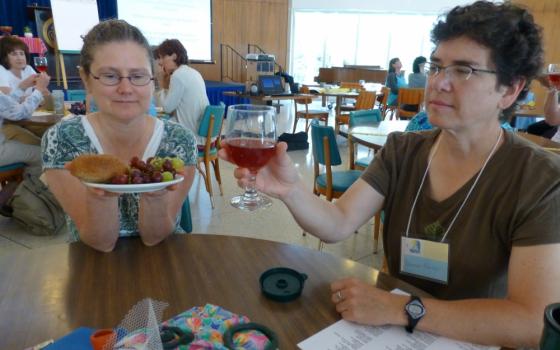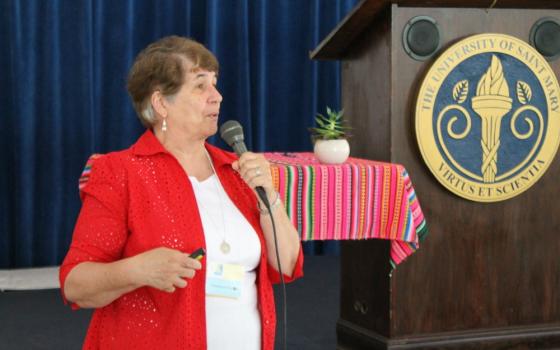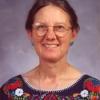I finish reading The Invention of Wings as we approach the cobblestone driveway of St. Mary University, Leavenworth, Kan. Usually, I consider myself a good traveling companion, but I could not put down Sue Monk Kidd’s fictionalized history of the Grimké sisters, Sarah and Angelina (Nina). Monk’s story takes us into the lives of the sisters who were at the forefront of the abolitionist and women's rights movements while we wind around the narrative of a young slave, Hetty. The Invention of Wings hangs like an aura about me as I walk into St. Joseph Hall to register for the Sisters of Earth conference.
To my surprise, on each table in the meeting room sit jars with painted lady butterfly cocoons attached to twigs, creatures in their cells, transforming, inventing wings, waiting to burst forth and fly freely into an amazing and vast world.
The weekend of July 10-13 women gathered as Sisters of Earth to explore “The New Emerging Humanity: Healing the Wholeness” – or the re-invention of wings. Organizers of the weekend invite the questions: What is possible for us as an emergent species in an unfolding universe? What is our growing edge? What is trying to emerge? How can we evolve ourselves by coming together in new ways collectively?
For over 20 years, Sisters of Earth have forged new paths to a future of harmony between the human community and the whole Earth community, inspired by the thought of Passionist Priest Fr. Thomas Berry and Jesuit Fr. Pierre Teilhard de Chardin. The sisters have recreated food production, engaged in advocacy, created new Earth literacy curriculums and Earth prayers. What is next?
In one of many inspiring presentations Loretto Sr. Maureen McCormack grappled to find words describing the evolutionary path forward in this moment so fraught with world conflicts, poverty, climate change and so many challenges. “The force forward is an astounding energy that is not about me,” she said. “It is larger than me and is a radical new identity with aspirations that when a whole group awakes creates a strong force that is a driving force following a thread . . . spiritual awakening out of which an awakening of humanity is possible.”
I scribble The Invention of Wings in my notes as I gaze at the cocoon on the table.
She continued, “Don’t give into voices of limitation that say, ‘I do not have time.’ There is no time to wait!”
There is a burning urgency to evolve now, until everything in the universe is numinous and extraordinary and known as sacred. Ambivalence is the biggest obstacle to the awakening of cosmos. This is the moment to be “whole hearted” and that is what gives energy. Whenever we are engaged in something in a half-hearted way we find ourselves depleted. Something unimaginable is waiting to be born.
The many presentations, experiences and conversations of the weekend were certainly whole-hearted.
Sr. Mary O’Rourke, CSJ, eco-feminist, microbiologist and educator talked about her work at an eco-spirituality center in Chile, and Sr. Kathy Wright, SL, shared stories about stopping the Bluegrass Pipeline and supporting renewable energy.
I was inspired by the U.N. work of Sr. Caroljean Willie, SC, who shared “What Does Faith Have to Do with Sustainability;” Sr. Toni Nash, CSJ, offered the integration of the New Story of Thomas Berry into our lives and religious traditions.
As we sang, danced, prayed and explored the meaning of the emerging humanity. I kept asking the questions: But what is emerging? What is the next step? The emerging humanity must move forth in the context of cosmology and new awareness of being part of Earth; in awareness of interdependence; with a desire to make a positive contribution; within diversity and in the context of new collaborations.
The work and invitation of Jennifer Morgan, president of the Deep Time Journey Network unveiled one new opportunity that brings these elements together; the online Deep Time Journey Network connects people from diverse fields of science, art, religion and education to share resources, work, questions and collaborations to further the work.
Urban ecology is another emerging field some Sisters of Earth talked about. Since the majority of the world’s population lives in cities, this is where the greatest transformation is possible in energy use, roof gardening, utilizing empty lots for food production, water harvesting, solar and wind need to occur. A new urban frontier beckons while offering an opportunity for new forms of community.
Intentional community conversations fluttered about dinner tables during the weekend – communities where listening to and supporting one another is vital in order to address the common good and systemic change. Intergenerational sharing of work, creativity and spirituality with youth and elders connecting in significant ways must happen to forge an emerging future. Embracing and exploring the possibilities of social media and initiatives such as Deep Time Journey Network are essential in addressing the complexities of climate change and social concerns.
Inserting ourselves into the world of policy advocacy in a way that holds a spiritual center and openness to unlikely collaborations beckons some. Amidst all, it is important to continue to reflect and theologize experiences. What might a Theology of Deep Time look like, and how might it serve us into the future?
As we sang “I am one hundred voices and I am singing, we are not alone,” a few of our painted lady butterflies began to emerge. We carried them outdoors. Several principles of the emergent human came to me as blessings for my winged sisters. Stretch beyond assumptions, trust goodness at the heart of world, hold the tension between beauty and destruction, change is not linear and love from a deep place of gratitude.
[Joan Brown, OSF, is executive director of New Mexico Interfaith Power and Light and a member of the Franciscan Sisters of Rochester, Minn. She may be reached at [email protected].]


